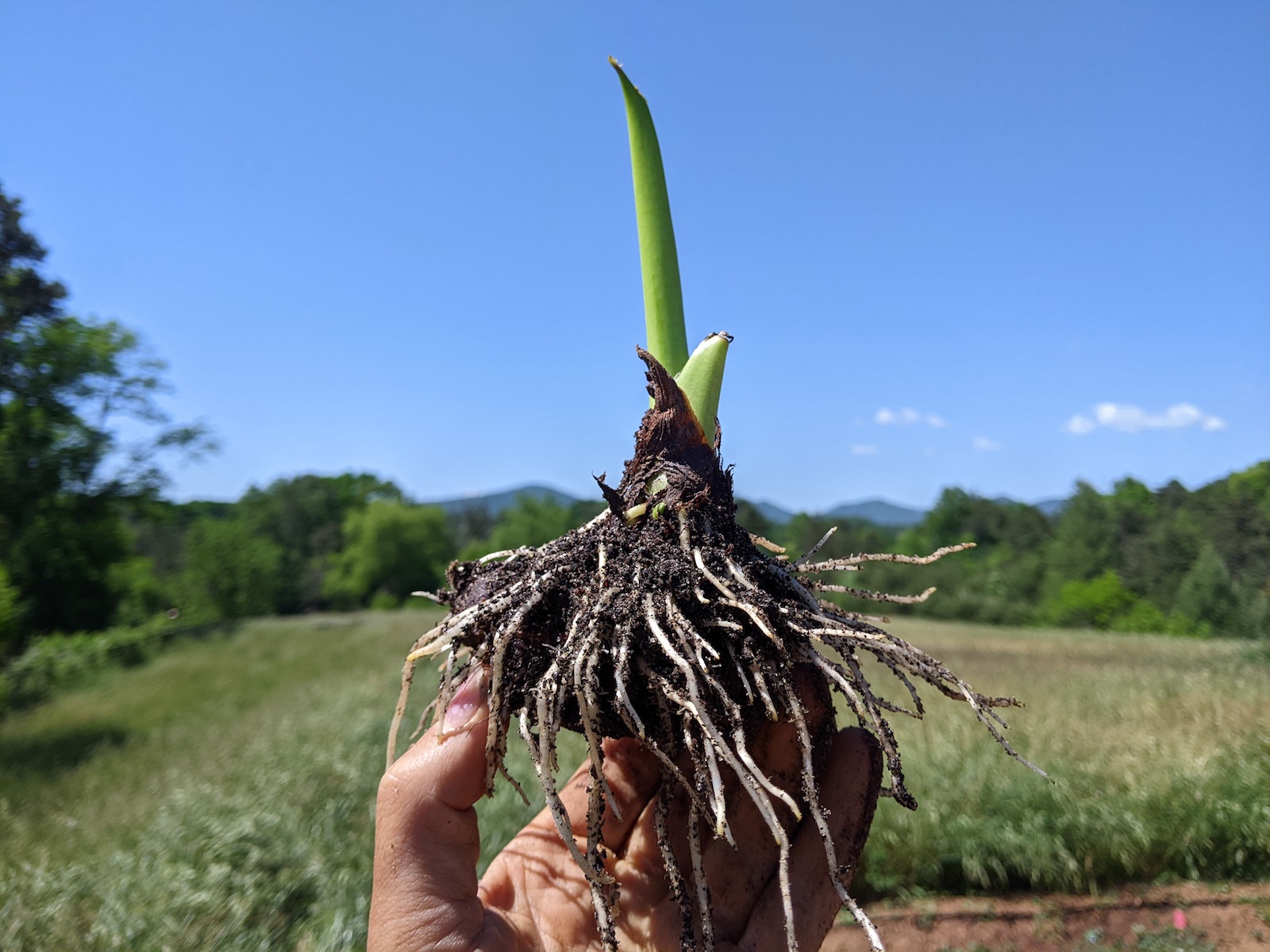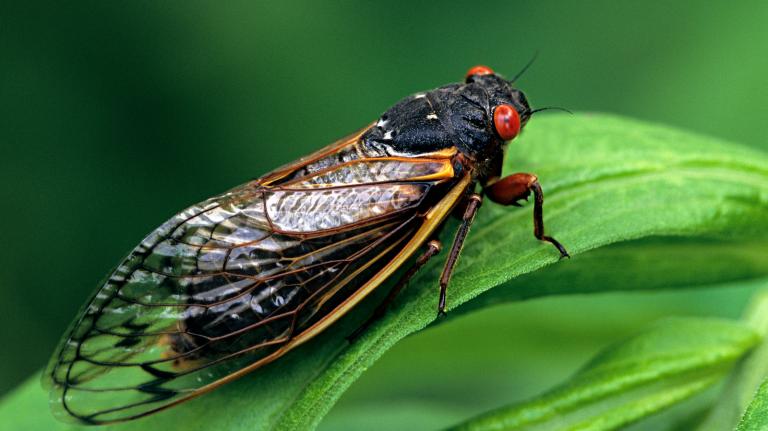The first time Chris Smith tried to grow taro on his experimental farm in western North Carolina, the plants were too eager. He’d started them in a heated greenhouse one February day a few years ago, thinking the tropical crop would need plenty of time to establish. Within a month, the taro had sprung up a foot and a half. Their heart-shaped leaves crowded the small greenhouse, but it was too early to transplant them into the still-cold ground. “That was a fail,” said Smith, the founder of the nonprofit Utopian Seed Project.
In the tropics, the starchy, lavender-hued root vegetable is grown year-round. But even North Carolina’s relatively mild winters aren’t taro-friendly. Smith and his team have kept tinkering with taro, as part of their wider effort to diversify farming — work that would not only make the food system more resilient to climate change, they thought, but also more delicious. Now, they start the seedlings in mid-April, or directly sow offshoots of the mother plant into the ground, deep enough to withstand any late frosts.

As temperatures rise and rainfall grows erratic, planting different crops is one way farmers can adapt to climate change. Rising heat in Michigan, for instance, has prompted a boom in vineyards and widened the range of grape varieties that can be grown there, leading some to speculate that the Midwestern state could be the next wine hub. In Kansas, as rainfall declines, cotton is flourishing in fields once dedicated to wheat and corn. And in the Southeastern U.S., tropical crops like taro look particularly attractive. But that does little good for farmers if their customers don’t know how to eat it. In his mission to introduce taro to the Southeast, Smith is working with farmers, customers, and chefs alike — making an effort to cultivate taro and create a market for it.
In many countries, taro is a staple, and it’s among the world’s oldest cultivated plants. First grown in southeast Asia, taro made its way across the Pacific around 1,500 years ago in the canoes of Polynesian voyagers who traveled the open ocean before making new lives in Tahiti and Hawaii. (While climate change may give the crop a leg-up in the southern U.S., rising temperatures and severe storms are threatening taro in Hawaii, where it’s part of the native Hawaiian creation story.) Root to leaf, the entire plant is edible, though it needs to be cooked first, since taro contains high amounts of oxalic acid, which is usually linked to kidney stones. It can withstand stretches of days without rain because its hairy corms, or potato-like roots, store water. And its broad, sturdy leaves can stand up to heavy rain.

The quest to grow taro in the South reflects a broader theme in efforts to protect agriculture from the hazards of climate change: diversification. “If I put all my eggs in one basket, say all I grow is watermelon, and I get hit with a pretty nasty disease, I lose everything that year,” said David Suchoff, an alternative crops specialist at North Carolina State University who studies plants like hemp and sesame. Or, one year may be dry, another too wet. “We need to be able to weather that better,” Suchoff said. Some plants endure heat or dry spells better than most, while others may be immune to emerging fungi and bacteria. Diversity — meaning both different kinds of crops and different varieties among a particular crop — offers natural protection from pests, disease, and extreme weather.
The global food system is anything but diversified: It’s propped up by three crops — rice, wheat, and corn — that supply half the world’s calories. One NASA study found that in the next ten years, climate change could cut into the yields of wheat and corn by as much as 17 and 24 percent, respectively. Experts say diversifying the food system will help it recover faster when inevitable disruptions come.

That led Smith and his Utopian Seed Project to experiment with tropical crops: bambara, achira, cassava, taro. Most of those plants grow in the tropics year-round, but in North Carolina, the farmers had to figure out how to save the plant material over the winter until it could be re-planted the following spring. It’s the same puzzle farmers solved for now-ubiquitous tomatoes and sweet potatoes, which also originated in the tropics. Taro soon distinguished itself as a high-performer. Taro was easy to grow. It could also be grown organically, and without extra heating or lighting.
Just as important, taro is tasty. Even more versatile than a potato, taro can be steamed, fried, boiled, and braised into sweet and savory dishes alike. Asian-American and Black chefs in Asheville were eager for a local supply. “It’s not like everything we’re doing is about preparing for catastrophe,” said Smith, who pointed to a broad nutritional base and wide representation of cuisines as benefits of a diversified food system.
This summer, with the help of a U.S. Department of Agriculture grant, the Utopian Seed Project scaled up their research trials. Partnering with two farms in the Southeast, they’ll study several varieties, including Korean, Filipino, and Hawaiian taro. The farmers will track costs, yields, and sales, providing a mountain of economic data. At the nonprofit’s farm, different plots will undergo various treatments to compare planting time, planting methods, watering methods, and harvesting techniques.

One of their partners is Michael Carter Jr., who runs Carter Farms in the Piedmont region of Virginia, which has been in his family since 1910. Carter had spent several years living in West Africa, where he couldn’t get enough of kontomire, a spicy stew with taro leaves and ground melon seeds, called egusi. When he returned to the U.S., he started experimenting with taro and found it easy to grow. After his first harvests, he dropped some greens off to a couple of stores catering to African immigrants in northern Virginia, and they were snatched up within minutes. “I can’t grow nearly enough to meet the demand,” Carter said.
Carter felt happy to provide beloved, but hard-to-find produce for people. He knew what it was like to crave certain veggies when far from home; when he lived in West Africa, much as he loved the kontomire, he still hankered for broccoli every now and then. And the taro could benefit people who hadn’t grown up eating it, too. Carter, who focuses on traditional African crops, believes diversifying food production can help African Americans connect with what he calls “culturally appropriate foods.” Although some consider collards as synonymous with African American cooking, they had their start in the eastern Mediterranean, and were brought to North America by Europeans in the 1600s. “You won’t buy collards in West Africa, but you will find taro leaves,” Carter said. “This is the right path back home.”
Before food producers adopt something new, they need to know there’s a market for it. Chefs and stores, on the other hand, want to know they can get a steady supply before they take on a new ingredient or product. Suchoff said a system-based approach is key. “The challenge is, if there’s no market for a crop, it doesn’t matter how drought-tolerant it is or how heat-tolerant it is,” he said. “If the farmer can’t sell it, it’s not really of much use.”

In his taro crusade, Smith works both sides of the equation, offering farmers information from field tests and giving chefs samples from the harvest. To drum up diners’ enthusiasm, the Utopian Seed Project recently held a tasting event with chefs in the area. Cleophus Hethington, previously the head chef of the Asheville restaurant Benne on Eagle, used taro greens to make epis, a Haitian base for stews and sauces. He blended the root into rice-like flecks before stewing it in coconut milk to make creamy, taro-based grits.
Hethington, who was recently nominated for a national James Beard Emerging Chef award, had been cooking food of the African diaspora on a busy block in a historically Black neighborhood, now the heart of the city’s tourist industry. It had been difficult, at times, to cook the food that he did when people in Asheville often weren’t familiar with it. “Once they get the exposure and experience, they see the connectivity and that’s the fun part of it,” Hethington said. “But I can’t say it comes without struggle.”
To Smith, these challenges speak to the nature of change in the food system: “It’s a slow process, to really integrate this food in a way that makes sense and could have lasting change.” One of the chefs he’d worked with asked when they could get a case of taro every week. Smith said it’d take a couple of years.



